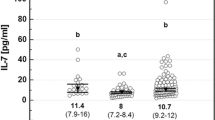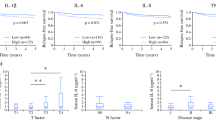Abstract
Current research has still not clarified the biological role of soluble interleukin(IL)-2 receptor (sIL-2R) and the significance of its increase in the serum of colon cancer patients compared to healthy subjects. To address these questions at the immunological level in a group of patients and healthy subjects, we determined the sIL-2R level in the serum and its release from peripheral blood mononuclear cells (PBMC) as a function of tumour necrosis factor (TNF) α, IL-1α, IL-1β, IL-2, interferon (IFN) γ, IL-4, IL-6 and IL-10 levels in the serum and PBMC production; and PBMC proliferative responses to IL-2, IL-4 and anti-CD3 monoclonal antibody (CD3), variously combined. The level of sIL-2R in patients’ serum was higher than in healthy subjects and correlated with the stage of advancement. Moreover, while in healthy subjects the serum level of sIL-2R was not significantly correlated with other parameters, in patients it was positively related to IL-4, IL-6 and IL-10 serum levels, PBMC IL-4 production and to the PBMC proliferative response to CD3 and CD3+IL-2; it was negatively correlated to IL-2 serum level and IL-1β PBMC release. A negative connection between IFNγ serum level and the PBMC production of sIL-2R was also found. This suggests that the increase of sIL-2R in the serum of patients, compared to healthy subjects, is involved in the inappropriate expansion of the T helper (TH2) suppressive immune response, which we previously reported. The multivariate statistical method supported the above suggestions and we also found that, in healthy subjects, the up- and down-regulation of sIL-2R in the serum within the physiological ranges seems to have a regulating role in the relationships between TNFα, IFNγ and IL-4, IL-6, contributing to the operation of the cytokine network between TH1 and TH2 cells. However, in patients compared to healthy subjects the increased sIL-2R serum level seems to direct the immune response towards a suppressive type, which may be due to an alteration in the above-mentioned physiological regulating role.
Similar content being viewed by others
Author information
Authors and Affiliations
Additional information
Received: 12 April 1997 / Accepted: 4 September 1997
Rights and permissions
About this article
Cite this article
Berghella, A., Pellegrini, P., Del Beato, T. et al. The significance of an increase in soluble interleukin-2 receptor level in colorectal cancer and its biological regulating role in the physiological switching of the immune response cytokine network from TH1 to TH2 and back. Cancer Immunol Immunother 45, 241–249 (1997). https://doi.org/10.1007/s002620050439
Issue Date:
DOI: https://doi.org/10.1007/s002620050439




